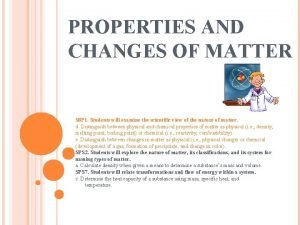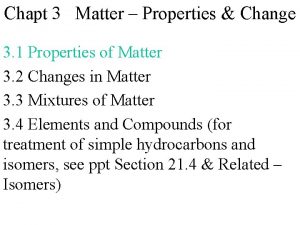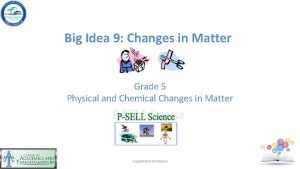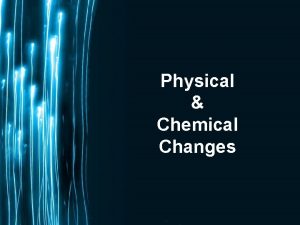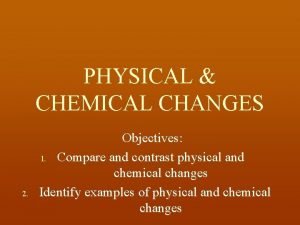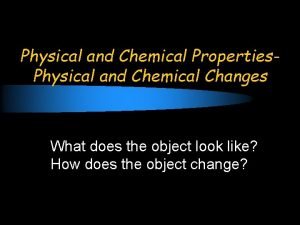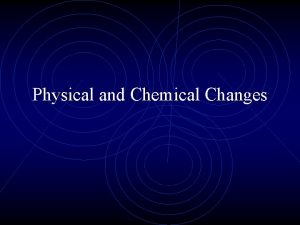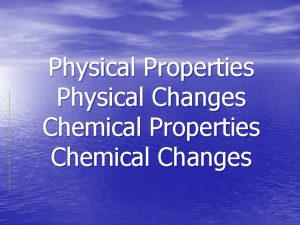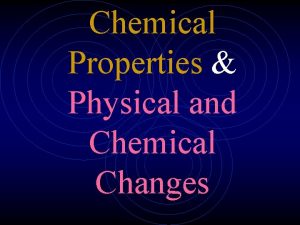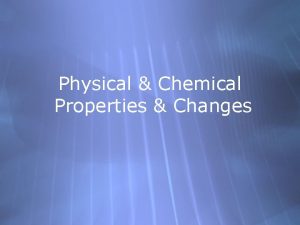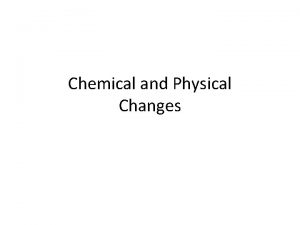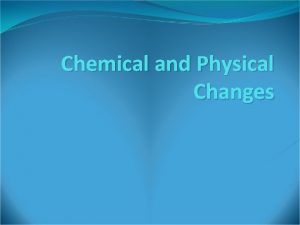Changing Matter Physical Chemical Changes Matter has properties












- Slides: 12

Changing Matter Physical & Chemical Changes

Matter has properties Two basic types of properties that we can associate with matter. Physical properties Chemical properties

Physical Properties Anything that can be observed without changing the identity of the substance. (Tends to be measurable. ) • melting point • boiling point • electrical conductivity • color • • density thermal conductivity ductility malleability

Chemical Properties The way a substance may change or react to form other substances • • • heat of combustion reactivity with water PH Oxidation Flammability • Reactivity to other chemicals

Matter can be changed two ways Physically Physical reaction Physical change Chemically Chemical reaction Chemical change

Physical Changes Do NOT CHANGE THE TYPE OF MATTER Nothing new or different is formed Could be a change in: Mass Size Volume Density Change in state Color Shape

Examples of Physical Changes Boiling Freezing Dissolving Breaking Making a mixture 2 or more types of matter (substances) mixed together Not in specific amounts Can be separated physically

Chemical Changes The composition of the substance changes. The substances present at the beginning of the change are not present at the end; new substances are formed. The change cannot be “undone. ” Picture from www. chem 4 kids. com

Chemical Changes Evidence of a chemical reaction Formation of gas Formation of precipitate Change in color Change in energy Endothermic Absorbs heat energy (gets cold) Exothermic Releases heat energy (gets hot)

Chemical Changes Atoms are re-arranged, NOT created or destroyed

Law of Conservation of Matter is conserved type of atoms does not change Nothing is created or destroyed

Law of Conservation of Mass is conserved amount of atoms cannot change Nothing is created or destroyed
 Physical changes of matter
Physical changes of matter Physical/chemical changes & properties color by number
Physical/chemical changes & properties color by number True or false: chemical and physical changes alter matter.
True or false: chemical and physical changes alter matter. Chemical property definition
Chemical property definition Chemical reactions section 1 chemical changes
Chemical reactions section 1 chemical changes Chemical properties and changes lesson 4
Chemical properties and changes lesson 4 Properties and changes of matter worksheet
Properties and changes of matter worksheet Matter-properties and changes answer key
Matter-properties and changes answer key Big idea 9 changes in matter
Big idea 9 changes in matter Physical and chemical changes
Physical and chemical changes Compare and contrast physical and chemical changes
Compare and contrast physical and chemical changes Physical and chemical changes
Physical and chemical changes Sawing wood chemical or physical change
Sawing wood chemical or physical change






